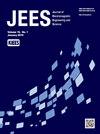Three-Dimensional Near-Field to Far-Field Transformation for Radar Cross Section Estimation of Elongated Targets via Subdimensional Hybrid Conversion
IF 1.7
3区 工程技术
Q3 ENGINEERING, ELECTRICAL & ELECTRONIC
Journal of electromagnetic engineering and science
Pub Date : 2022-07-31
DOI:10.26866/jees.2022.4.r.116
引用次数: 0
Abstract
Image-based (IB) near-field to far-field transformation (NFFFT) is a useful method for the valid prediction of radar cross sections (RCSs) from short-range monostatic measurements. Many previous studies on the IB NFFFT algorithm have been limited to two-dimensional (2D) measurement cases. In this work, a subdimensional hybrid conversion approach is proposed as a relevant three-dimensional (3D) NFFFT method consisting of the following procedures. First, the spherical-wave information collected through 3D scanning is converted to a cylindrical waveform by applying the 2D circular NFFFT (CNFFFT) method to every vertical subplane (r-θ plane). Then, a horizontal far-field radar image on the x-y plane and an RCS pattern are extracted through direct integration of a 2D focusing operator modified to compensate for a magnitude error through distance approximation during the CNFFFT procedure. The results of a comparative study with direct integration of a 3D focusing operator are presented to show the validity and performance of the proposed method.三维近场到远场变换用于细长目标雷达截面的亚维混合转换估计
基于图像(IB)的近场到远场变换(NFFFT)是一种有效预测雷达截面积(rcs)的方法。以前关于IB NFFFT算法的许多研究都局限于二维(2D)测量情况。在这项工作中,提出了一种子维度混合转换方法,作为相关的三维(3D) NFFFT方法,由以下步骤组成。首先,通过对每个垂直子平面(r-θ平面)应用二维圆形NFFFT (CNFFFT)方法,将三维扫描采集到的球波信息转换为圆柱波形。然后,通过直接积分二维聚焦算子来补偿CNFFFT过程中通过距离逼近产生的幅度误差,提取x-y平面上的水平远场雷达图像和RCS方向图。通过与直接集成三维聚焦算子的对比研究,验证了该方法的有效性和性能。
本文章由计算机程序翻译,如有差异,请以英文原文为准。
求助全文
约1分钟内获得全文
求助全文
来源期刊

Journal of electromagnetic engineering and science
ENGINEERING, ELECTRICAL & ELECTRONIC-
CiteScore
2.90
自引率
17.40%
发文量
82
审稿时长
10 weeks
期刊介绍:
The Journal of Electromagnetic Engineering and Science (JEES) is an official English-language journal of the Korean Institute of Electromagnetic and Science (KIEES). This journal was launched in 2001 and has been published quarterly since 2003. It is currently registered with the National Research Foundation of Korea and also indexed in Scopus, CrossRef and EBSCO, DOI/Crossref, Google Scholar and Web of Science Core Collection as Emerging Sources Citation Index(ESCI) Journal. The objective of JEES is to publish academic as well as industrial research results and discoveries in electromagnetic engineering and science. The particular scope of the journal includes electromagnetic field theory and its applications: High frequency components, circuits, and systems, Antennas, smart phones, and radars, Electromagnetic wave environments, Relevant industrial developments.
 求助内容:
求助内容: 应助结果提醒方式:
应助结果提醒方式:


